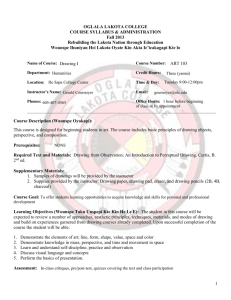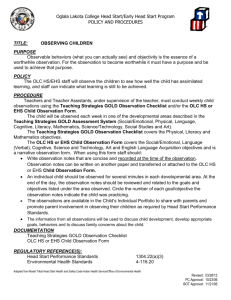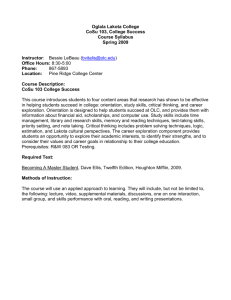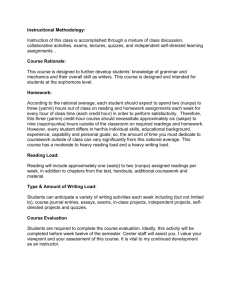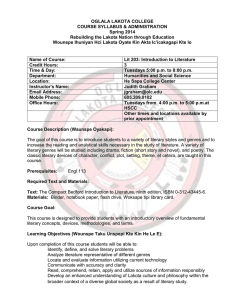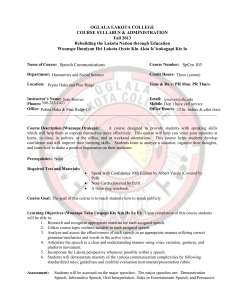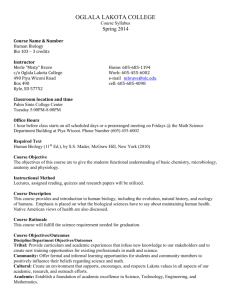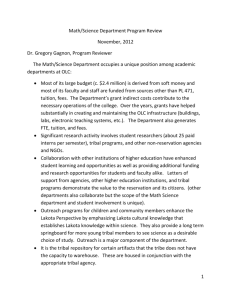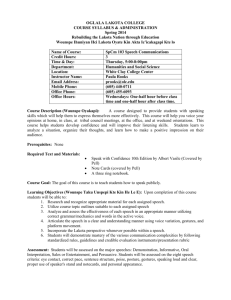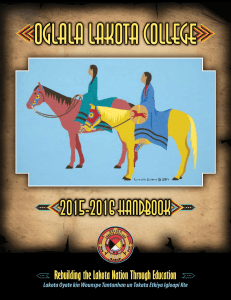ART 123 Two Dimensional Design PR_Fall
advertisement
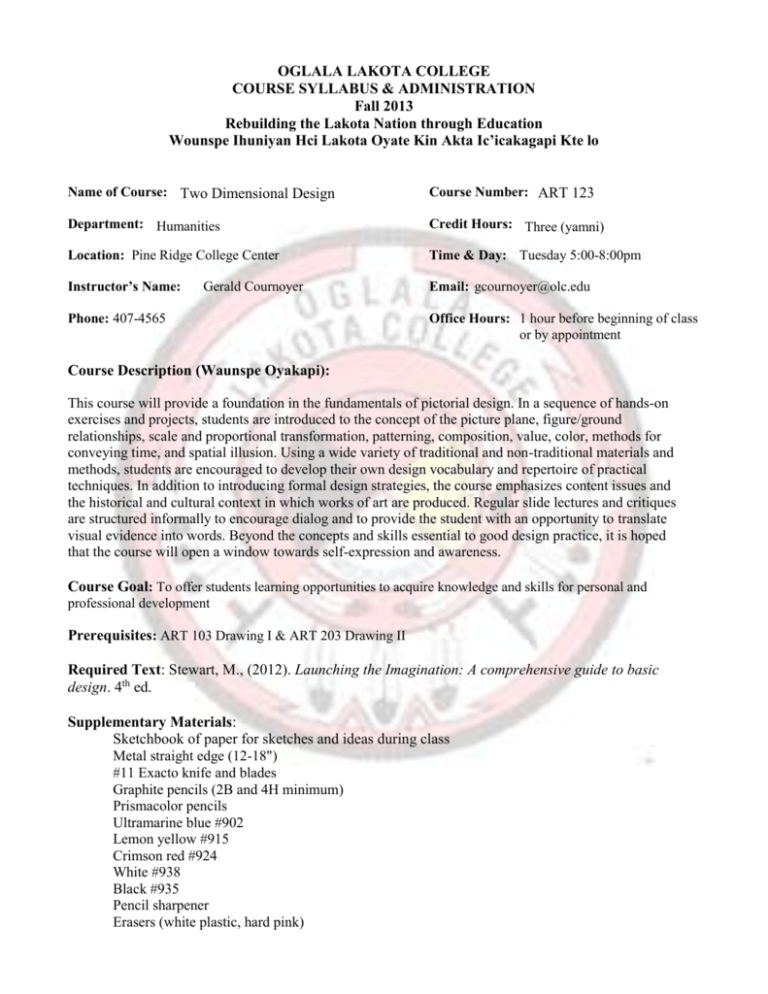
OGLALA LAKOTA COLLEGE COURSE SYLLABUS & ADMINISTRATION Fall 2013 Rebuilding the Lakota Nation through Education Wounspe Ihuniyan Hci Lakota Oyate Kin Akta Ic’icakagapi Kte lo Name of Course: Two Dimensional Design Course Number: ART 123 Department: Humanities Credit Hours: Three (yamni) Location: Pine Ridge College Center Time & Day: Tuesday 5:00-8:00pm Instructor’s Name: Email: gcournoyer@olc.edu Gerald Cournoyer Phone: 407-4565 Office Hours: 1 hour before beginning of class or by appointment Course Description (Waunspe Oyakapi): This course will provide a foundation in the fundamentals of pictorial design. In a sequence of hands-on exercises and projects, students are introduced to the concept of the picture plane, figure/ground relationships, scale and proportional transformation, patterning, composition, value, color, methods for conveying time, and spatial illusion. Using a wide variety of traditional and non-traditional materials and methods, students are encouraged to develop their own design vocabulary and repertoire of practical techniques. In addition to introducing formal design strategies, the course emphasizes content issues and the historical and cultural context in which works of art are produced. Regular slide lectures and critiques are structured informally to encourage dialog and to provide the student with an opportunity to translate visual evidence into words. Beyond the concepts and skills essential to good design practice, it is hoped that the course will open a window towards self-expression and awareness. Course Goal: To offer students learning opportunities to acquire knowledge and skills for personal and professional development Prerequisites: ART 103 Drawing I & ART 203 Drawing II Required Text: Stewart, M., (2012). Launching the Imagination: A comprehensive guide to basic design. 4th ed. Supplementary Materials: Sketchbook of paper for sketches and ideas during class Metal straight edge (12-18") #11 Exacto knife and blades Graphite pencils (2B and 4H minimum) Prismacolor pencils Ultramarine blue #902 Lemon yellow #915 Crimson red #924 White #938 Black #935 Pencil sharpener Erasers (white plastic, hard pink) 1 technical ink pen--sizes .25 - .5 will do. Disposable pens are fine. Masking tape ("drafting" tape that won't pull off paper) Protractor with degrees Watercolor brushes (synthetic white sable) White palette or mixing tray (small) Cold pressed illustration board, 15 x 20" Tracing paper (roll, 16 - 18" wide) Water container Portfolio for carrying 2-D work (17 x 22 min.) and a box for materials Glue stick Gouache (opaque watercolor) Ivory Black Zinc White Brush cleaner or mild soap. Three ring notebook with 8 1/2 x 11" paper for notes, thumbnail sketches, collages. Learning Objectives (Wounspe Taku Unspepi Kte Kin He Le E): Upon completion of this course students will be able to: 1. Use the principles of design to develop individual creative designs and dynamic compositions. 2. Use a variety of strategies to create and evaluate the creative problem-solving process through intuitive processes, revisions and risk-taking, to arrive at a final composition. 3. Demonstrate proper use of diverse media and materials to produce a work of art. 4. Evaluate and critique works of art and presentation by using art terminology. 5. Identify historic references within the theory and practice of design. 6. Organize a portfolio of works that demonstrate aesthetic understanding of the principles of design, elements of form, and appropriate presentation of art. Assessment: In-class critiques, pre/post-test, quizzes covering the text and class participation Instructional Methodology: This course will be taught utilizing instructor demos, lecture-discussion format, field trips to galleries and museums, and artist studios. Homework: Each student should expect to spend two (nunpa) to three (yamni) hours out of class on reading and completing assignments each week, for every hour of class time (each credit hour), in order to perform satisfactorily. Therefore, if a course is three (yamni) credit hours you should spend approximately six (sakpe) to nine (nepcunka) hours outside of the classroom on required readings and assignments. Reading Load: Reading will include approximately one (wanji) to two (nunpa) chapters per week, plus handouts and homework as assigned. Lakota Perspective Provided Through: This course stresses Wolakolkiciyapi of “learning Lakota ways of life in the community”. This course is based on the values of mutual respect and generosity (Woohola na wochantognakapi), seeking to advance each individual’s knowledge through their continuing hard work (fortitude- Wowacin Tanka) and willingness to learn new information and viewpoints, as well as to demonstrate it, by speaking in front of the group (bravery-Wohitika); all undertaken in an environment of complete truthfulness, trust, integrity and humility. We will do this by embracing the teaching of our ancestors as we learn new ways. (Waunspe wicakiyapi ki iglutanyan ihani unpi kun hena itan waunspe tokeca uha ayin kte.) Evaluation and Grading: Homework will consist of practice in techniques. In addition, there will be in-class exercises and practice and quizzes. Projects (4) Quizzes (8) Final Group Project 30% of your grade 30% of your grade 40% of your grade Evaluation: Final grades will be determined by the student’s acquired knowledge of design techniques and the quality of submitted projects. Students will be evaluated on: 1. Effort: involvement and self-motivation 2. Aesthetic accomplishment and craft (quality of work) 3. Creative solutions (risk taking and imagination) 4. How well the completed project meets the criteria outlined in the original assignment 5. Sketch book of design ideas 6. Late work will be graded down, 10 points for each late week. A = Superior Quality Work = Demonstrated concept mastery by scoring 90% or better. B = Good Quality Work = Demonstrated concept mastery by scoring 80-89%. C = Satisfactory Quality Work = Demonstrated concept mastery by scoring 70-79%. D = Marginal Quality Work = Demonstrated weak concept mastery by scoring 60-69% F = Demonstrated concept mastery below the acceptable mark of 59%, which is well below what may be required in the business world. W = Withdrawal = A student may withdraw from a course by filling out a Drop Card to be recorded by the Registrar. The student must sign this form if you drop yourself. A Drop Card may/can be filled out and signed by a counselor/instructor for lack of attendance. College Policy on Grading and Change of Grades: http://www.olc.edu/~wwhitedress/studentservices/Docs/OLC_Handbook.pdf see page 9 and 10 Course Requirements and Expectations: Because OLC offers classes in three-hour blocks once per week, (for everyone’s travel convenience), if you are absent from one OLC class session, it’s like missing three classes at another college Students are to be ready to work at the beginning of the class and promptly after breaks with all the necessary material and equipment set in place. Students must not spend class time to acquire the materials. A day’s class consists of a 20 minute instructor demo before student in-class practice begins. Majority of class time will be utilized as in-class working time. Two (2) breaks will be taken during each class meeting. Students should use this time to check their work for accuracy and self-evaluation. It is critical for the students to follow the instructions and guidelines given by the instructor– failure to do so will result in the final grade of C- or below. i.e. procedure, preparedness, project deadline. If not certain about the instructions and/or project deadlines, it is suggested that students maintain a notebook. It is highly recommended that students not miss the demo session. Instructor demos cannot be repeated for individual students who were absent. Students are responsible for any class material and/or information (project due date, class material etc.) that they may have missed out due to their absence. You are expected to participate in class discussion; this provides evidence of your interest in and preparation for the class. It also helps gauge the effectiveness of the instruction and everyone’s level of comprehension of the material presented. Most importantly, fellow class members benefit from your opinions and insights; in addition, the questions you ask may be about the same topic with which other students are having difficulty, so by helping yourself you also help them. Attendance and Tardiness http://www.olc.edu/~wwhitedress/studentservices/Docs/OLC_Handbook.pdf see page 6 Students are required to attend class weekly. Instructors will submit attendance on-line weekly to the end of the semester. If a student wishes to be excused from a class, it is the student's responsibility to clear the absence with the instructor. However no make up assignments will be allowed. A student will be dropped from the Two Dimensional Design course after three consecutive absences and will be dropped by the Registrar after five total absences. There are NO reinstatements and No exceptions for students who are dropped for five absences Policies on Academic Honesty http://www.olc.edu/~wwhitedress/studentservices/Docs/OLC_Handbook.pdf see page 38 Standards of Conduct Policy http://www.olc.edu/~wwhitedress/studentservices/Docs/OLC_Handbook.pdf see page 32 ADA Policy http://www.olc.edu/~wwhitedress/studentservices/Docs/OLC_Handbook.pdf see page 37 Oglala Lakota College recognizes physical and mental disabilities that include mobility, sensory, health, psychological, and learning disabilities, and provides reasonable accommodations and/or referrals once the disability is adequately documented. While Oglala Lakota College’s legal obligations only extend to disabilities of a substantial and long-term nature, it is also the College’s practice to honor reasonable requests for accommodations and/or referrals for temporary disabilities such as a physical injury, illness, or complicated pregnancy*. In keeping with the Americans with Disabilities Act (ADA) and with section 504, Oglala Lakota College can only provide accommodations and/or referrals to ensure students with disabilities equal access to education. The college does not alter curriculum or provide services that would be construed as “special education.” ADA Procedure It is the responsibility of the student to make his or her disability and needs known in a timely fashion and to provide appropriate documentation and evaluations to support the accommodations the student requests. Once admitted the student must notify the Coordinator of Support Services by filling out an Application for Service. Once the college has been notified and specific accommodations are requested and appropriately documented, the College will work with the student to obtain the approved accommodations and/or referrals to ensure the student has the opportunity to equal access to education. Oglala Lakota College will provide all students with information regarding the disability policy and OLC’s accommodation request procedures via the college’s website, student handbook, college catalog, and instructor’s syllabus. These accommodations and/or referrals may not affect the substance of the educational programs or compromise educational standards and will be provided by Oglala Lakota College to the best of the College’s ability bases on the resources that it has. Department Vision The vision for the Associate of Art in Fine Art Degree at Oglala Lakota College is to provide high quality, peer reviewed and peer assessed Fine Art education for its tribal students in better preparing them for a career and enhanced Lakota life in Fine Art on and off the Pine Ridge Indian Reservation. Students and graduates will have a solid, competitive foundation to pursue a Bachelor of Fine Art Degree while developing new art vocabulary and techniques that remain specific and unique to sophisticated Lakota traditional philosophies and thought. Department Mission The mission for the Associate of Art in Fine Art Degree at Oglala Lakota College provides a program in which students will: • Experience and underline the richness of art aesthetics while implementing Wolakolkiciyapi; • Develop and practice an ability to analytically, steadily create artworks for peer review; • Construct collegiate level written and oral communication skills relevant to arts skills enhancement; • Acquire, analyze, research, and broaden knowledge of world cultures, religions, histories, and economies through art; • Employ the ability to locally market art production on and off the Pine Ridge Indian Reservation, online, and elsewhere; • Interpret art making as a form of post-traumatic healing for Oceti Sakowin indigenous locally; • Participate in the community outreach/civic engagement branch of the AA of Fine Art Degree, the OLC Artist Consortium. Department Philosophy The philosophy of the AA in Fine Art Degree program at Oglala Lakota College is to offer the breadth of diverse courses in Fine Art to engage and challenge students to develop comprehensions of global art and entrepreneurial dynamics while remaining grounded and engaged in Oglala Lakota traditions. Date Oko Wanci 8/28/12 Oko Nunpa 9/4/12 TOPICAL CONTENT Objectives by Chapter Review of syllabus Discussion of Chapter 1: Basic Elements Discussion of Chapters 1and 2 Assignments Pre-test Quiz over chapters 1 and 2 Introduction of Project 1 Oko Yamni 9/11/12 Oko Topa 9/18/12 Elements of Color in class activity Discussion of Chapter 3 Continue working on Project 1 Quiz over Chapter 3 Oko Zaptan 9/25/12 Oko Sakpe 10/2/12 Discussion of Chapter 4 Critique of Project 1 Quiz over Chapter 4 Discussion of Chapter 5 Quiz over chapter 5 Oko Sakowin 10/9/12 Oko Saglogan 10/16/12 In class activity – Problem Seeking/Problem Solving Oko Napcinyunka 10/23/12 Oko Wikcemna 10/30/12 Oko Ake Wanci In class activities – Creative Thinking Introduction of Project 2 Discussion of Chapter 6 Discussion of Chapter 7 In class activities – developing critical thinking Quiz over Chapter 6 Critique of Project 2 Quiz over Chapter 7 Introduction of Project 3 11/6/12 Oko Ake Nunpa 11/13/12 Oko Ake Yamni 11/20/12 Oko Ake Topa 11/27/12 Oko Ake Zaptan 12/4/12 Discussion of Chapter 8 Final Project Quiz over Chapter 8 Critique of Project 3 Introduction of Project 4 (Group Project) Group presentations Final Project Group presentations Group Collaboration – Constructing Meaning from Art Disclaimer: Information contained in this syllabus was, to the best knowledge of the instructor, considered correct and complete when distributed for use at the beginning of the semester. However, this syllabus should not be considered a contract between Oglala Lakota College and any student. The instructor reserves the right to make changes in course content or instructional techniques without notice or obligation. Students will be informed of any such changes. Additional student rights and responsibilities are outlined in the Student Handbook. http://www.olc.edu/~wwhitedress/studentservices/Docs/OLC_Handbook.pdf
